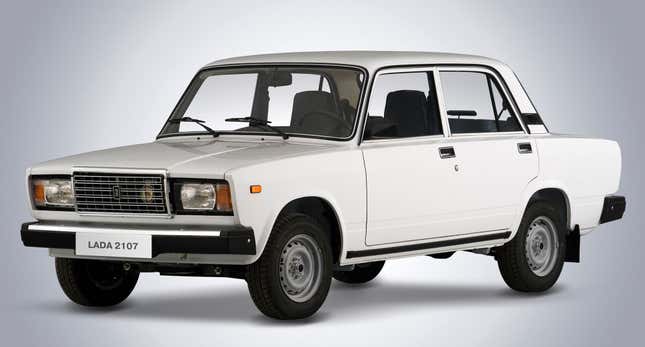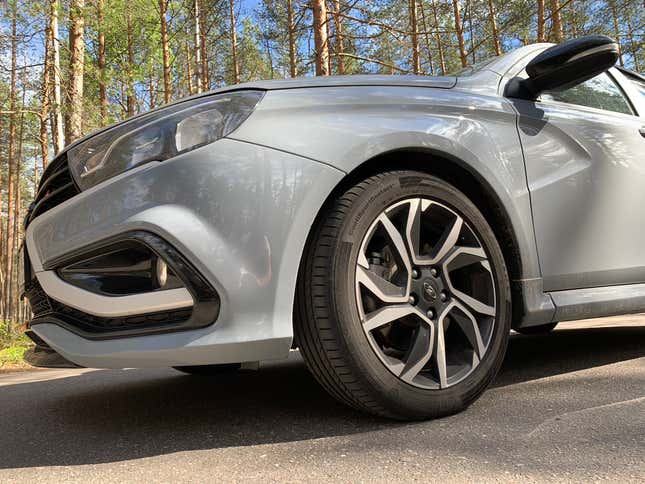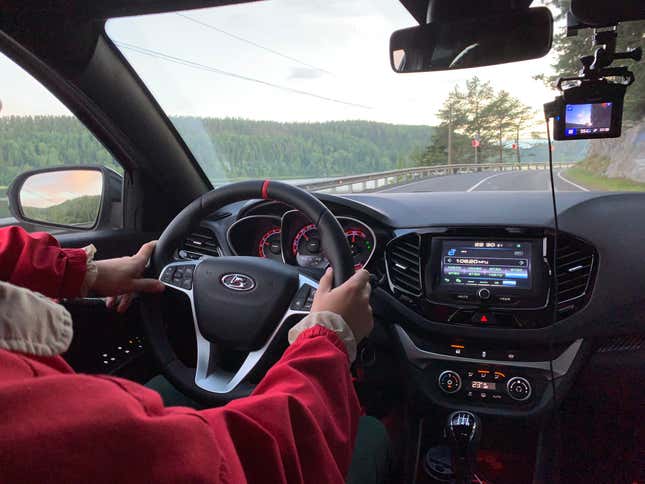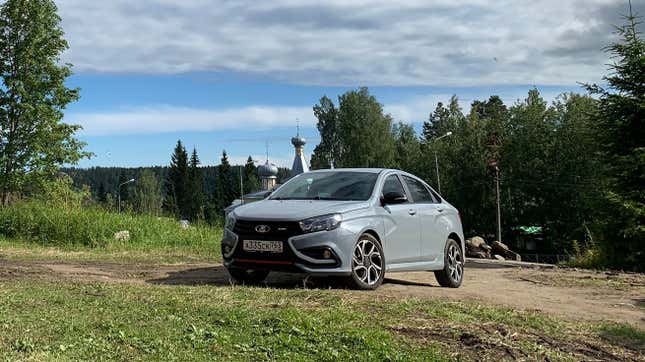It’s impossible to talk about Russian cars without delving into stereotypes. And this is because America is among the few places in the world where Russian cars—namely Ladas—were never sold. So whatever perceptions of Lada may exist in the states, they generally aren’t based on people living with them.
Popular culture has filled this void with low-hanging fruit: Cold War Era jokes. The incessant Russian Reversal bit, immortalized by Family Guy: “In Soviet Russia, car drives you!” Jeremy Clarkson in a fur hat, wielding a hammer, standing next to a Lada Riva—painted in a color that matches the break room at the Chernobyl Nuclear Power Station.
And what hasn’t helped Lada’s image in this regard is that, less than nine years ago, you could go to your local Lada dealer and buy this:

Stereotypes are hard to break when stuff like, uh, that still exist.
But the Lada Vesta Sport changes things. This thing is a clean break from a Soviet past that has, in many ways, overstayed its welcome.
After partnering with Renault-Nissan in 2012, Lada has been reinventing itself. But the Vesta Sport is no badge-engineered, Renault a la Russe; it’s rooted in tech that long predates Lada’s partnership with the West. And, in an ever homogenous automotive world, it’s nice to see something different.
And though the Lada Vesta Sport isn’t free of problems, these problems, I should note, are at last 21st century problems.
(Full Disclosure: I took an overnight train from Saint Petersburg to Moscow, where Lada let me borrow a 2019 Vesta Sport with a tank of gas.)
What Is It?

The Vesta platform was introduced in 2016 as Lada’s flagship offering. In 2018, the Vesta became Russia’s best selling car.
The Vesta Sport, in turn, is a factory tuned version of the mass-production Vesta. It is to Lada what the Fiesta ST is to Ford, or what the Golf GTI is to Volkswagen. (Sort of.)
And while the ordinary Vesta starts at 579,000 rubles or about $9,000 (with prices going up if you opt for the automated-manual transmission or the larger 1.8-liter engine). The Lada Vesta Sport is priced at over 1,000,000 rubles or about $16,000. That’s one million rubles.
It’s the most expensive Vesta you can buy. Moreover, it’s the most expensive production Lada in history. So whatever it is that makes the Lada Vesta Sport, well, Sport costs nearly as much as the base Vesta itself.
Specs That Matter

Lada Sport, a motorsport-oriented subsidiary of Lada, has made over 200 changes to the Vesta in order to bring Sport into its name.
The Vesta Sport is lower by 31 millimeters in the front and by 17 millimeters in the rear. The front suspension is fully redesigned it has front fenders made out of plastic. There’s a rear spoiler as well as a front lip splitter that’s very red—the kind of red that you’d associate with boxing gloves, matadors, and Ferrari, but definitely not Communism. Plus, it has dual exhaust pipes that aren’t 50 percent fake.
In the front, behind 17 or optionally 18-inch alloys, you’ll find the largest ever brake discs installed on a Lada, though I don’t know if that really tells you anything.

Under the hood, the 1.8 liter inline-four often found in normal Vestas has been blessed with beefier cams and a high-flow exhaust, among other changes. This has boosted horsepower from 122 to 145 HP, the redline from 5,900 to 6,000 RPM, and some additional torque as well.
Yes, in a world of Hellcats and LS-swapped dishwashers, it’s hard to use “145 horsepower” and “sport” in the same sentence. But the ~$15,000 sports- economy-car segment is kind of a thing in Russia—just not in North America. The Vesta Sport actually does have direct competitors, like the 125 horsepower Volkswagen Polo, ahem, “GT.”
On The Inside
The first thing you’ll notice on the inside is a red stripe at the top of the steering wheel—yes, that Ferrari-boxing-matador red. The redness continues in the form of stitching around the steering wheel and along the shifter.
It then spills onto “Alcantara-type” seats and appears, in digital form, on the instrument panel. The theme carries into the night, when you’ll notice the red LEDs illuminating the metallic pedal assembly, which feels very Midnight Club.

The interior is a nice place to sit—provided you aren’t averse to the color red. But there are some strange contradictions: the seats feel like they belong in a much more expensive car, but the power window switches feel—and sound—like the clicks of a computer mouse from the mid ‘90s. The climate control is simple, easy to use, and well-positioned. But, just above, is perhaps the greatest let-down of all: a touch-screen multimedia display as responsive as an iPhone that’s been partially digested by a large dog.
In Traffic
I picked up the Vesta Sport in Moscow on a weekday. So, straight off the press lot, I merged onto the shuddering conveyor belt that is afternoon traffic. And while it took roughly forty-five minutes to get into second gear, I did learn some interesting things in that time.
I was flanked on all sides by Land Cruisers and Audis that I didn’t even know existed. And the Muscovites inside them kept staring at the Vesta Sport; they were intrigued.
And it’s not hard to see why. Because the Vesta lends itself to the swelling and bloating that occurs when regular cars are sportified. The flared fenders and air vents don’t appear misplaced or disproportionate. For the most part, it’s all pretty tasteful.

As traffic thickened, I eventually heard screaming. And this screaming went on for some time, until I noticed two men in matching Armani sunglasses, sticking their heads out of a Mercedes, pointing and yelling in my direction. And, as this was my first-ever press car, I immediately thought something was wrong. Perhaps, in a fog of excitement and anxiety, I pulled away from the press lot too quickly, and the Lada rep’s arm was still attached to the passenger door. So, in a panic, I listened in closely, and the men screamed:
“ЭЙ! БРАТАН!” (“HEY BRO!”)
“БРАТАААН!!!” (“BROOOOO!!!)
“КАКОЙ ОБЪЕМ?!” (“WHAT’S YOUR DISPLACEMENT?!”)
And, at this point, I was thoroughly taken aback. A $16,000 Lada, in a megapolis with possibly more Cayennes than Corollas, was turning heads.
On The Highway
Eventually, I managed to get into second gear and even third gear, merging onto the recently built expressway connecting Moscow to Saint Petersburg. And it was there that I explored the far-reaches of fourth and fifth gear.

Cruising at three digit speeds alongside cars worth, at the very least, three times more than the Vesta Sport was a pleasant surprise. The steering is very tight and reliably on-center. The suspension dealt with bumps at high speed very appropriately, with no wobbles to report. The car is remarkably poised at high speed not just by $16,000 standards, but by any standard.
For a few hundred miles, you can—legally, at least—go 149 kilometers an hour (92 mph). And, for those few hundred miles, the car felt welded to the pavement. But the problem was getting to those speeds.
For all that Lada Sport did to tweak the 1.8 liter i-4, it doesn’t seem to have a tangible effect on acceleration. According to factory figures, the Vesta Sport can get up to 60 mph in 9.7 seconds, which is about a second quicker than the ordinary 122 HP Vesta.
This made for a contradictory highway driving experience. The chassis feels up for speeds far beyond what the powertrain can provide. And this wasn’t the only time I came across this sort of power-handling asymmetry.
The underwhelming power is less noticeable while cruising on divided highways. But when it comes to overtaking trucks on undivided, two-lane roads (a very common maneuver in Russia) it gets scary.
If you need to accelerate quickly, you’ll find yourself in the higher rev-range, because mid-range power is nowhere enough. Which brings up another issue.
Believe it or not, the Lada Vesta Sport is loud—especially on the inside. And I suspect, with some evidence, that it’s because sound insulation wasn’t prioritized. When I asked one of Lada’s reps to give me a ride in a regular and very handsome Vesta Station Wagon, I noticed an immediate drop in cabin volume. Either way, if you’re cruising on the highway at 3,000 RPM—and you inevitably will because there is no sixth gear—the engine noise will be, to put it lightly, noticeable.

But maybe it isn’t fair to fault the car for the noise. It does have “Sport” in its name which, at least in theory, comes at the expense of comfort. The same can be said about other modern cars with needlessly uncomfortable and impractical low-profile tires. So Lada should have just followed in the footsteps of Lamborghini and Porsche, who have perfected the art of removing your car’s stereo and door handles for extra money. If it were called Vesta Superleggera, the noise wouldn’t have bothered me or anyone else.
On Fun Roads
After an 800 kilometer drive from Moscow to Saint Petersburg, I realized that I had only driven the Vesta Sport in a straight line. So I set out for the granite cliffs along the north shore of Lake Ladoga—the largest lake in continental Europe. In an otherwise sea-level region, here you’ll find a treasure-trove of tight bends, elevation changes, and some magnificent views.

The road, connecting Saint Petersburg to Sortavala, a small city in the Republic of Karelia, weaves through mossy boreal forests teeming with mushrooms and wild berries. Tall, orange Scandinavian Pines stand uncomfortably close to the shoulder.
In these conditions, the Vesta Sport really started to make sense. And, between heel-toe downshifts into tight corners, all the extra engine noise was more than welcome. All of the changes Lada Sport made to the suspension revealed themselves in the corners. Forget about body roll. This is, perhaps, the best handling car that can be had for around $15,000. And the much larger brakes did their part as well.
But you couldn’t understeer the Vesta Sport even if you tried. There just isn’t that much power.
Verdict
In spite of its contradictions, the Lada Vesta Sport is a fundamentally good car. And by this I mean that the Vesta’s most noticeable problems also happen to be the most solvable. Yes, the infotainment screen and power window switches suck. And while these issues are obvious and frustrating, they have simple solutions: better screens and better buttons.
And, of course, the Vesta Sport could certainly benefit from more power. But, again, it’s important to consider $16,000 price tag. Lada Sport did what it could with a small, naturally aspirated four cylinder engine that isn’t all too powerful to begin with, while keeping costs relatively low.
However, if the Vesta Sport was unbalanced and handled terribly, that would point to much deeper and less solvable problems. Yet, in this case, Lada Sport has built a car that handles quite well, both on the highway and on hairpin curves.
More importantly, the Vesta Sport is changing perceptions of the Lada brand where it matters most: in its Russian homeland.

Lada isn’t the only brand that’s undergone a rapid transformation in recent years. Think of the Hyundai of 2019—a company that produces competitors to BMW and some of the greatest hot hatches of our time. Now try and recall the Hyundai of 2003. Remember the Accent? I’m sure Hyundai doesn’t want your children to know what a 2003 Accent looked like.
The point is: transformation for the better is possible in the automotive world. And if the Vesta Sport is any indication, Lada may very well be going through one.

